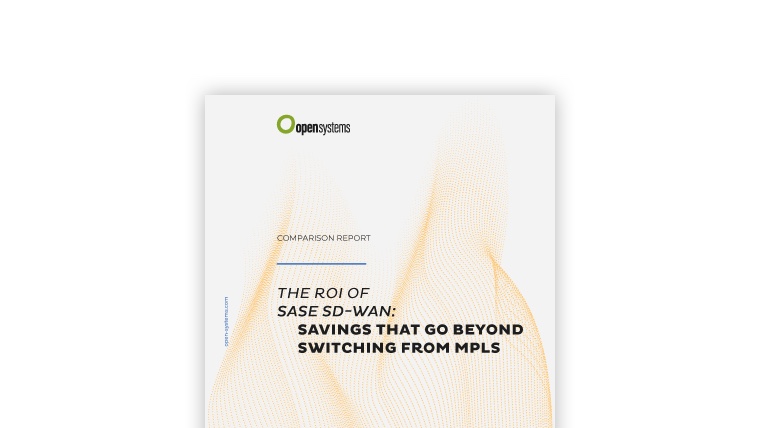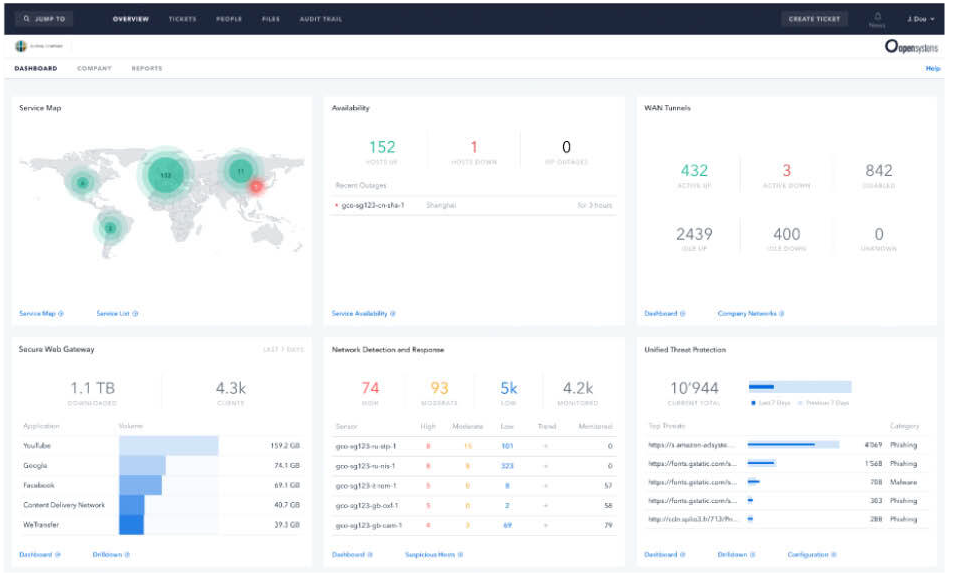
Benefits of SD-WAN
The traditional WAN infrastructure is limited to connecting data centers to remote branches and sites or users across a widely distributed campus. WANs experience an unprecedented surge of traffic when organizations adopt a cloud-first strategy. Legacy hub-and-spoke WANs were not designed to manage the volume and unpredictable nature of internet and cloud network loads. IT professionals are adding cost-correct broadband services to relieve the strain on their WANs and meet their users’ service level requirements.

On average, roughly 70% of enterprise applications run on the cloud or with a SaaS provider

The SD-WAN market is expected to grow from USD 1.9 billion in 2020 to USD 8.4 billion in 2025

The growth of the global SD-WAN market from 2020 to 2025 represents a CAGR of over 34%
Managing a Hybrid Network is Not a Simple Task
Managing a patchwork of different networks, connections, applications, clouds, and technologies while maintaining user satisfaction and cybersecurity is challenging. IT professionals are transforming their infrastructures into an SD-WAN (software-defined WAN) to overcome these challenges.

SD-WAN benefits are numerous in comparison to the benefits of traditional WANs. SD-WANs deliver the intelligence and agility needed to unify traditional WANs and newer broadband connections into a single, easy-to-administer, secure, software-defined network. Policies and service level agreements dynamically manage SD-WANs. Traffic is no longer directed along a predetermined path but along the path that will ensure the prescribed quality of service. Traffic routing is automatic and dynamic, requiring minimal administration.


SD-WAN Benefits are Becoming Business Imperatives
The competitive nature of today’s business environment requires organizations to be cost-efficient, fast, and secure. Like the organizations they serve, networks need to be the same. SD-WAN benefits include the following business necessities:
- Leading SD-WAN vendors integrate unified cybersecurity. Cybersecurity technologies are seamlessly layered over the entire managed SD-WAN. Unlike a patchwork of ad hoc point security solutions, leading SD-WANs are centrally managed. Security maintenance and upgrades are centrally implemented and monitored, eliminating the possibility of inadvertently creating a security vulnerability or breach. Security is simple to manage even as the SD-WAN continues to evolve and expand.
- A comprehensive SD-WAN includes EDR (Endpoint Detection and Response), which combines real-time continuous endpoint monitoring with AI-driven threat detection to identify and react to threats early in the kill chain. As the edge of the SD-WAN extends further, having robust EDR is critical to quickly identifying and mitigating security vulnerabilities before they become a threat.
- SD-WAN security policies and technologies with end-to-end real-time access control, segmentation, deep traffic inspection, and AI-driven threat detection are a few of the security mechanisms that provide a layered approach to ensuring cybersecurity.
- SD-WAN services must include SOC-as-a-Service. Globally connected cybersecurity experts monitor the SD-WAN and respond to threats 24 x 7 x 365 to elevate and maintain a high-security posture and support regulatory compliance.
- SD-WANs define multiple and diverse active connections for all networked applications, ensuring user performance expectations are met.
- Easy to expand network bandwidth, performance management, and end-to-end reach address sudden surges in network traffic or unplanned expansion to encompass additional users, sites, clouds, and applications.
- Application-aware bandwidth prioritization and intelligent routing provide the optimum user experience with predictable service for all connections and applications.
- Network traffic monitoring identifies existing and potential hotspots and dynamically reroutes traffic to meet service level agreements.
- SD-WANs ensure continuous access to applications by defining multiple failover paths. If a physical connection suffers an outage or degraded performance, traffic is automatically routed through alternative paths to maintain a high level of user satisfaction.
- SD-WANs select MPLS WAN or broadband services to deliver the most cost-correct connection for various applications.
- SD-WANs ensure user productivity and avoid poor service penalties by providing continuous and consistent performance using embedded performance management technologies.
- With SD-WANs, IT professionals can replace or augment expensive Multiprotocol Label Switching (MPLS) services with more economical and flexible broadband infrastructures.
- Connection costs are significantly reduced for new sites and applications when delivering SD-WAN services from the cloud.
- Connection costs are reduced by optimizing bandwidth with SD-WAN intelligent traffic monitoring, shaping, and load balancing.
- Costs associated with technology evaluation, integration, and life-cycle management are eliminated and provided by the SD-WAN service.
- SD-WAN services should be all-inclusive to avoid complex and hidden pricing schemes.
Security
Comprehensive cybersecurity technologies must be built into the fabric of the SD-WAN. Cybersecurity addresses business imperatives for protecting applications, users, and networks.
Performance
SD-WAN performance benefits meet or exceed user expectations
Cost
SD-WAN cost benefits stretch budgets while improving operational efficiency.
Comprehensive cybersecurity technologies must be built into the fabric of the SD-WAN. Cybersecurity addresses business imperatives for protecting applications, users, and networks.
- Leading SD-WAN vendors integrate unified cybersecurity. Cybersecurity technologies are seamlessly layered over the entire managed SD-WAN. Unlike a patchwork of ad hoc point security solutions, leading SD-WANs are centrally managed. Security maintenance and upgrades are centrally implemented and monitored, eliminating the possibility of inadvertently creating a security vulnerability or breach. Security is simple to manage even as the SD-WAN continues to evolve and expand.
- A comprehensive SD-WAN includes EDR (Endpoint Detection and Response), which combines real-time continuous endpoint monitoring with AI-driven threat detection to identify and react to threats early in the kill chain. As the edge of the SD-WAN extends further, having robust EDR is critical to quickly identifying and mitigating security vulnerabilities before they become a threat.
- SD-WAN security policies and technologies with end-to-end real-time access control, segmentation, deep traffic inspection, and AI-driven threat detection are a few of the security mechanisms that provide a layered approach to ensuring cybersecurity.
- SD-WAN services must include SOC-as-a-Service. Globally connected cybersecurity experts monitor the SD-WAN and respond to threats 24 x 7 x 365 to elevate and maintain a high-security posture and support regulatory compliance.
SD-WAN performance benefits meet or exceed user expectations
- SD-WANs define multiple and diverse active connections for all networked applications, ensuring user performance expectations are met.
- Easy to expand network bandwidth, performance management, and end-to-end reach address sudden surges in network traffic or unplanned expansion to encompass additional users, sites, clouds, and applications.
- Application-aware bandwidth prioritization and intelligent routing provide the optimum user experience with predictable service for all connections and applications.
- Network traffic monitoring identifies existing and potential hotspots and dynamically reroutes traffic to meet service level agreements.
- SD-WANs ensure continuous access to applications by defining multiple failover paths. If a physical connection suffers an outage or degraded performance, traffic is automatically routed through alternative paths to maintain a high level of user satisfaction.
SD-WAN cost benefits stretch budgets while improving operational efficiency.
- SD-WANs select MPLS WAN or broadband services to deliver the most cost-correct connection for various applications.
- SD-WANs ensure user productivity and avoid poor service penalties by providing continuous and consistent performance using embedded performance management technologies.
- With SD-WANs, IT professionals can replace or augment expensive Multiprotocol Label Switching (MPLS) services with more economical and flexible broadband infrastructures.
- Connection costs are significantly reduced for new sites and applications when delivering SD-WAN services from the cloud.
- Connection costs are reduced by optimizing bandwidth with SD-WAN intelligent traffic monitoring, shaping, and load balancing.
- Costs associated with technology evaluation, integration, and life-cycle management are eliminated and provided by the SD-WAN service.
- SD-WAN services should be all-inclusive to avoid complex and hidden pricing schemes.
Open Systems SD-WAN
Open Systems industry leading SD-WAN provides tangible SD-WAN benefits through managed software-defined networking.
Contact our customer advocates to learn more or to obtain an assessment of how our managed SASE’s SD-WAN benefits can meet your new imperatives.

SD-WAN FAQ
What is SD-WAN?
SD-WAN, or Software-Defined Wide Area Network, is a system that manages network connectivity for a business over the cloud. As the world continues to advance technologically, remote access to a network has become increasingly important. SD-WANs use VPNs, broadband, internet, and other technologies to ensure all employees, regardless of distance, can access a company’s network securely without reducing network speed or efficiency.
What does SD-WAN stand for?
SD-WAN stands for Software-Defined Wide Area Network, referring to easy network access over wide geographical areas.
What is the difference between SD-WAN and traditional WAN?
Traditional WAN systems generally relied on a router and a specific geographic location for employees to access the company network. On the other hand, SD-WAN uses cloud capabilities, VPNs, the internet, and other tools to give employees remote access to company networks regardless of location. As technology has advanced, systems such as SD-WAN, have developed to facilitate remote access capabilities.
What are the main SD-WAN benefits?
SD-WAN benefits include the following:
- Maintaining high-speed networks – Traditional WAN systems slow down when there is an increase in cloud activity. SD-WAN uses cloud capabilities to help regulate network traffic without bogging down the system.
- Unifying cybersecurity technologies – SD-WANs include EDR, SOC-as-a-service, and other cybersecurity technologies to reduce the need for many different systems. Having too many cybersecurity systems can open vulnerabilities in the cybersecurity system. SD-WAN covers all the bases so that companies only need one cybersecurity system.
- Lowering cybersecurity costs – SD-WAN’s unifying cybersecurity capabilities help reduce cybersecurity costs so that a company’s budget can cover necessary protection systems.
Leave Complexity
Behind
To learn how Open Systems SASE Experience can benefit your organization, talk to a specialist today.
Contact Us



